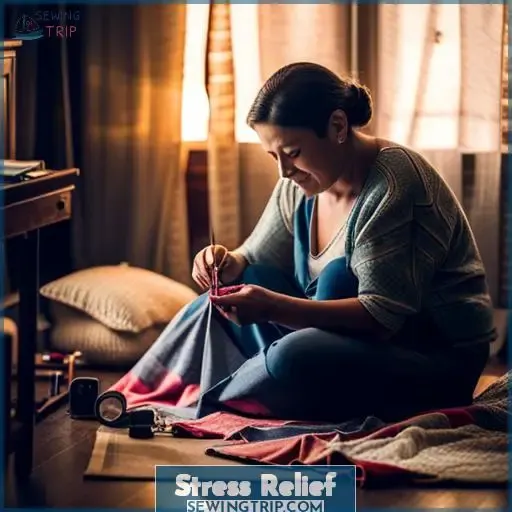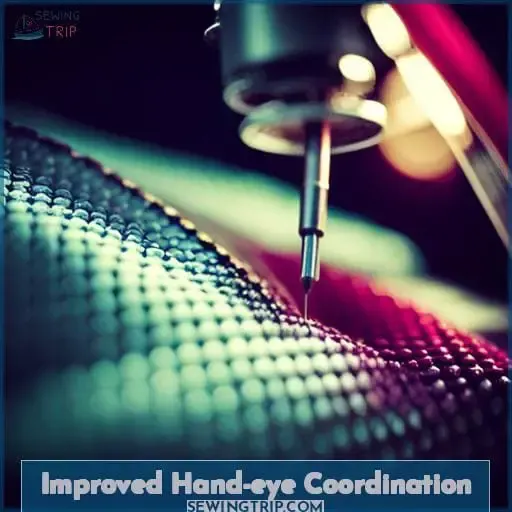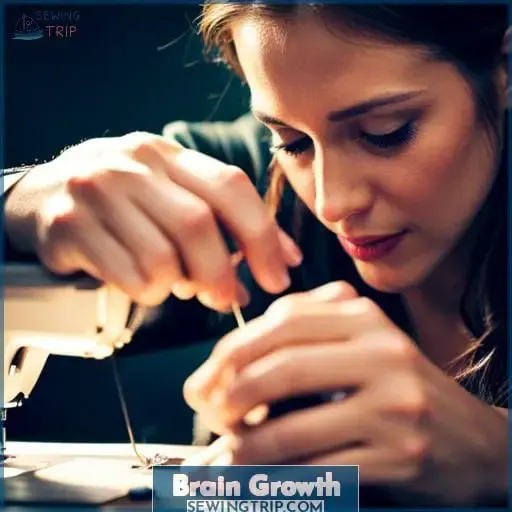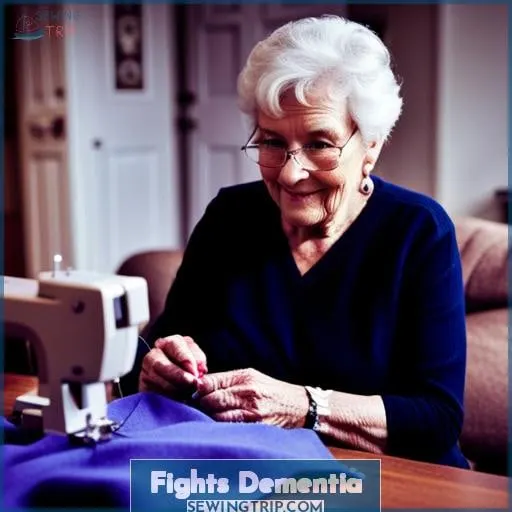This site is supported by our readers. We may earn a commission, at no cost to you, if you purchase through links.
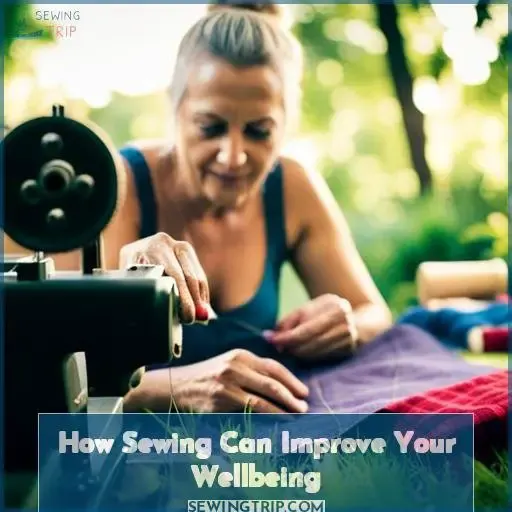 Sewing?! That’s so old-fashioned – didn’t our suffragette sisters throw off their sewing shackles ages ago? Yet here you are in 2023 – enlightened, empowered, eyes wide open – tempted to pick up needle and thread.
Sewing?! That’s so old-fashioned – didn’t our suffragette sisters throw off their sewing shackles ages ago? Yet here you are in 2023 – enlightened, empowered, eyes wide open – tempted to pick up needle and thread.
What spell has been cast? Perhaps it’s the promise of stress relief as you stab fabric in place of annoying co-workers.
Don’t forget happiness: nothing like embroidery floss to brighten your mood. Ultimately, you know deep down that sewing can promote wellbeing. It draws you back to life’s simple pleasures, liberates you from the digital world’s relentless demands, and returns autonomy over clothing and creativity.
Table Of Contents
Key Takeaways
- Sewing can serve as a stress relief technique and promote mindfulness through the repetitive motion and tactile focus on fabric.
- Engaging in creative activities like sewing can contribute to self-care and improve self-esteem.
- Sewing can foster social connections and community building, which can have positive effects on mental health and well-being.
- Sewing may have cognitive benefits, such as improving hand-eye coordination, stimulating brain growth, and potentially delaying dementia.
Stress Relief
You’d be amazed how losing yourself in a sewing project can relieve your stress and take your mind off worries. As your hands guide the fabric, your mind finds inner peace. The repetitive motion frees your thoughts to wander, yet keeps them focused just enough to express yourself through each creative stitch.
The required hand-eye coordination provides brain exercise while lowering stress. Positive feelings emerge as you progress through a design, practicing stress management skills. With every prick and pull of the needle, tension releases; inner turmoil smoothed out with each new seam pressed flat.
Improved Hand-eye Coordination
Let’s unwind those tangled threads of stress. Pick up your needle and feel the soothing motion of stitch after stitch. With each pass of the thread, focus intently on the cloth beneath your fingertips.
This mindfulness quiets your racing thoughts, empowering you to live fully in the present. Any lingering anxiety melts away as you become absorbed in your sewing. Make these moments for yourself often.
Keeping your hands and mind occupied with relaxing, creative activities like sewing is vital self-care.
Regularly carving out this space, free from digital distractions, is an act of emotional nurturing that boosts your well-being.
Brain Growth
Engaging in creative pursuits fosters fresh neurons, keeping the mind sharp.
- Sewing stimulates creativity through imaginative pattern choices and design.
- Completing sewing projects provides a sense of accomplishment and boosts self-esteem.
- The social connections formed in sewing circles build community and support mental health.
Studies by the American Heart Association have shown sewing to be an ideal coping mechanism and self-care routine. The cognitive stimulation of learning new techniques keeps the mind active and delays dementia.
Sewing gives you an empowering creative outlet and opportunities for connection. The Greene Medical Foundation recommends sewing as part of maintaining overall well-being.
Happiness
The simple repetitive motions of stitching bring you joy and contentment. As your fingers deftly guide the needle through the fabric, a sense of serenity washes over you. In these moments, the act of sewing becomes more than just a craft; it transforms into a gateway for emotional processing.
With every stitch, you weave your emotions into the fabric, creating a tangible reflection of your inner world.
This creative expression becomes a tool for mood enhancement, allowing you to channel your feelings into something beautiful.
Sewing doesn’t only connect you with your emotions; it also fosters a sense of community building. As you engage in this art, you join a tapestry of individuals who share your passion. Whether it’s swapping tips at a local sewing circle or showcasing your creations at a craft fair or gift shop, sewing unites like-minded souls.
Intergenerational bonding finds a home in this art form, as grandparents pass down their expertise to eager grandchildren.
Beyond personal enrichment, the impact of sewing extends to larger contexts. Hospitals partner with crafters to provide comfort items for patients undergoing chemotherapy treatments, while stroke survivors find solace in the rhythm of stitching, thanks to organizations like the American Stroke Association.
Capital improvement projects and even surgical review corporations utilize sewing to make a difference.
The thread that runs through these diverse applications is the inherent power of sewing to uplift and heal. The act of sewing, seemingly simple yet profoundly profound, carries within it the capacity for emotional growth, interpersonal connections, and meaningful contributions to both individual lives and society as a whole.
Fights Dementia
Immerse yourself in the artistry of crafting with fabric, connecting your hands and mind in a symphony of creativity that weaves together memories, emotions, and cognitive vitality. When it comes to fighting dementia and promoting overall well-being, sewing proves to be a powerful ally.
-
Tactile Stimulation: Sewing engages your sense of touch, offering a therapeutic tactile experience that stimulates your brain’s sensory receptors, enhancing your overall sensory awareness.
-
Memory Stimulation: Each stitch is a tiny, deliberate act that reinforces your memory. Remembering patterns, techniques, and fabric choices exercises your cognitive faculties, keeping your memory sharp.
-
Therapeutic Engagement: Sewing is a form of mindfulness, providing a meditative escape from the chaos of daily life. It calms your mind, reduces stress, and fosters emotional resilience.
-
Cognitive Maintenance: The mental demands of sewing, from pattern interpretation to precision stitching, keep your cognitive functions nimble, potentially offsetting cognitive decline.
-
Reminiscence Therapy: Creating or repairing garments can evoke cherished memories, serving as a form of therapy that connects you to your past, promoting mental well-being.
In the cancer center or clinical exam rooms, consider introducing sewing as a therapeutic activity to harness these cognitive and emotional benefits. It’s a powerful tool for nurturing well-being and fighting the effects of dementia.
Frequently Asked Questions (FAQs)
Certainly, here are 5 frequently asked questions that would not normally be answered in the following article sections: Stress Relief, Improved Hand-eye Coordination, Brain Growth, Happiness, Fights Dementia.
Discover how sewing can be a transformative tool for your well-being. Experience the soothing power of stitching as it melts away stress, while your nimble hands weave intricate patterns that stimulate brain growth and ignite happiness.
Are there specific sewing techniques or projects that are particularly effective in enhancing hand-eye coordination?**
Embark on a journey where threads weave magic into your fingertips. Unveil the mesmerizing artistry of embroidery, where stitches dance, forging a symphony between hand and eye. As you craft, your mastery ignites, claiming the realm of boundless coordination.
How does the act of sewing contribute to the formation of new neural connections in the brain?**
In the intricate dance of thread and fabric, sewing becomes a neural symphony. Each stitch is a note, weaving the melody of cognitive connections. The irony lies in this craft’s subtlety—it’s not just fabric that’s interwoven, but also the very fabric of your mind.
As your hands guide the needle, your brain orchestrates a masterpiece of neuron collaboration. The act of sewing, seemingly simple, creates a vibrant tapestry of new neural pathways, fostering mental agility and prowess.
So, while you sew to craft tangible beauty, remember that you’re also crafting the intangible masterpiece of your mind.
In what ways does the satisfaction derived from completing a sewing project contribute to a person’s overall sense of happiness?**
Completing a sewing project sparks a surge of satisfaction. Achieving tangible results taps into your innate desire for mastery, empowering your sense of accomplishment, fostering happiness, and igniting your journey to well-being.
Could engaging in sewing activities potentially delay or mitigate the onset of cognitive decline in aging individuals prone to dementia?**
Like a patient gardener tending to the blooms of memory, engaging in sewing stitches a tapestry of resilience in aging minds. Mindful creativity, tactile mastery, and cognitive dance intertwine, delaying dementia’s shadows.
Conclusion
Unleash the thread of tranquility and let the needle of positivity weave its magic – that’s how sewing metamorphoses into an enchanting symphony for your wellbeing.
As you’ve delved into this stitched tale, you’ve witnessed the profound impacts of sewing on mental health. From unraveling stress to threading the fabric of improved hand-eye coordination, sewing is a potion for cognitive growth that’s as rich as imagination itself.
With every stitch, you’re not just crafting fabric, but sculpting happiness and forging resilience. And as the tapestry of life unfolds, sewing stands as a formidable shield, fending off the shadows of dementia.
So, embrace this artful thread of self-care, and let the soothing hum of the sewing machine guide you to a haven of wellbeing.

